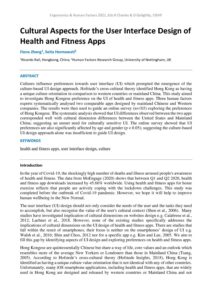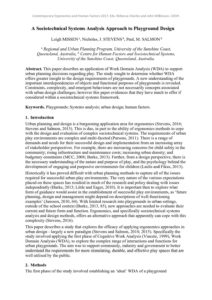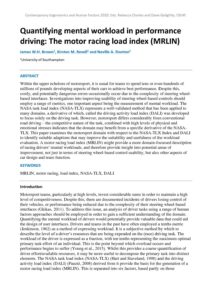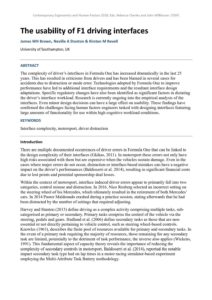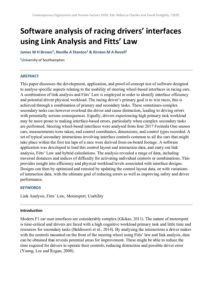Sport & leisure
Cultural Aspects for the User Interface Design of Health and Fitness Apps
| Document | Author Fiona Zheng and Setia Hermawati |
| Abstract Cultures influence preferences towards user interface (UI) which prompted the emergence of the culture-based UI design approach. Hofstede’s cross-cultural theory identified Hong Kong as having a unique culture orientation in comparison to western countries or mainland China. This study aimed to investigate Hong Kongese preference on the UI of health and fitness apps. Three human factors experts systematically analysed two comparable apps designed by mainland Chinese and Western companies. The results were then used to guide an online survey (n=103) exploring the preferences of Hong Kongese. The systematic analysis showed that UI differences observed between the two apps corresponded well with cultural dimension differences between the United States and Mainland China; suggesting an unmet need for culturally sensitive UI. The online survey showed that UI preferences are also significantly affected by age and gender (p < 0.05); suggesting the culture-based UI design approach alone was insufficient to guide UI design. |
A Sociotechnical Systems Analysis Approach to Playground Design
| Document | Author Leigh MISSEN a, Nicholas, J. STEVENS b, Paul, M. SALMON b |
| Abstract This paper describes an application of Work Domain Analysis (WDA) to support urban planning decisions regarding play. The study sought to determine whether WDA offers greater insight to the design requirements of playgrounds. A new understanding of the important interdependencies of objects and functional purposes of playgrounds is revealed. Constraints, complexity, and emergent behaviours are not necessarily concepts associated with urban design challenges; however this paper evidences that they have much to offer if considered within a sociotechnical systems framework. |
It’s not all about the bike: distributed situation awareness and teamwork in elite women’s cycling teams
| Document | Author Paul SALMON, Clare DALLAT, Amanda CLACY |
| Abstract This paper presents the findings from a study examining situation awareness and teamwork in elite women’s cycling. This involved observing an elite racing team during two Australian National Road Series race events and conducting post-race critical decision method interviews. The data were analyzed using the Event Analysis of Systemic Teamwork framework to show the task, social and situation awareness networks underpinning team performance. The findings are discussed in relation to enhancing cycling team performance and potential applications in other sports. |
Quantifying mental workload in performance driving: The motor racing load index (MRLIN)
| Document | Author James W.H. Brown, Kirsten M. Revell and Neville A. Stanton |
| Abstract Within the upper echelons of motorsport, it is usual for teams to spend tens or even hundreds of millions of pounds developing aspects of their cars to achieve best performance. Despite this, costly, and potentially dangerous errors occasionally occur due to the complexity of steering wheel-based interfaces. Investigations into improving usability of steering wheel-based controls should employ a range of metrics, one important aspect being the measurement of mental workload. The NASA task load index (NASA-TLX) represents a well-validated method that has been applied to many domains, a derivative of which, called the driving activity load index (DALI) was developed to focus solely on the driving task. However, motorsport differs considerably from conventional road driving – the competitive nature of the task, combined with high levels of physical and emotional stresses indicates that the domain may benefit from a specific derivative of the NASA-TLX. This paper examines the motorsport domain with respect to the NASA-TLX Index and DALI to identify suitable adaptions that may improve the suitability and usefulness of the workload evaluation. A motor racing load index (MRLIN) might provide a more domain-focussed description of racing drivers’ mental workloads, and therefore provide insight into potential areas of improvement, not just in terms of steering wheel-based control usability, but also other aspects of car design and team function. |
The usability of F1 driving interfaces
| Document | Author James WH Brown, Neville A Stanton & Kirsten M Revell |
| Abstract The complexity of driver’s interfaces in Formula One has increased dramatically in the last 25 years. This has resulted in criticisms from drivers and has been blamed in several cases for accidents due to distraction or mode error. Technologies adopted by Formula One to improve performance have led to additional interface requirements and the resultant interface design adaptations. Specific regulatory changes have also been identified as significant factors in dictating the driver’s interface workload. Research is currently ongoing into the empirical analysis of the interfaces. Even minor design decisions can have a large effect on usability. These findings have confirmed the challenges facing human factors engineers tasked with designing interfaces featuring large amounts of functionality for use within high cognitive workload conditions. |
Software analysis of racing drivers’ interfaces using Link Analysis and Fitts’ Law
| Document | Author James W H Brown, Neville A Stanton & Kirsten M A Revell |
| Abstract This paper discusses the development, application, and proof-of-concept test of software designed to analyse specific aspects relating to the usability of steering wheel-based interfaces in racing cars. A combination of link analysis and Fitts’ Law is employed in order to identify interface efficiency and potential driver physical workload. The racing driver’s primary goal is to win races, this is achieved through a combination of primary and secondary tasks. These sometimes-complex secondary tasks can however overload the driver and cause distraction, leading to driving errors with potentially serious consequences. Equally, drivers experiencing high primary task workload may be more prone to making interface-based errors, particularly when complex secondary tasks are performed. Steering wheel-based interfaces were analysed from four 2017 Formula One season cars, measurements were taken, and control coordinates, dimensions, and control types recorded. A set of typical secondary interactions involving interface controls common to all the cars that might take place within the first ten laps of a race were derived from on-board footage. A software application was developed to load this control layout and interaction data, and carry out link analysis, Fitts’ Law and hybrid calculations. The analysis revealed a range of data, including traversal distances and indices of difficulty for activating individual controls or combinations. This provides insight into efficiency and physical workload levels associated with interface designs. Designs can then by optimised and retested by updating the control layout data, or with variations of interaction data, with the ultimate goal of reducing errors as well as improving safety and driver performance. |

